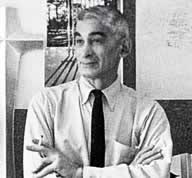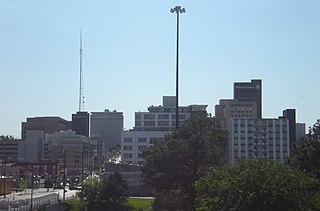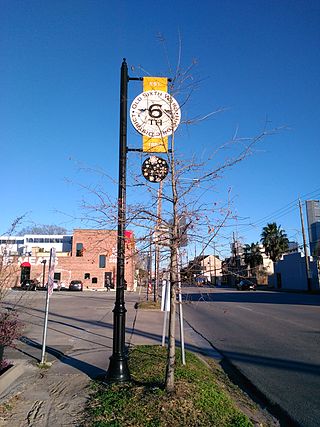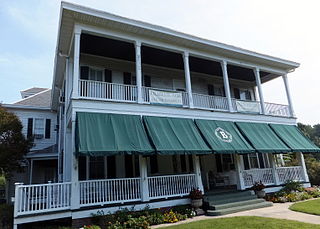
The Bishop's Palace, also known as Gresham's Castle, is an ornate 19,082 square feet (1,772.8 m2) Victorian-style house, located on Broadway and 14th Street in the East End Historic District of Galveston, Texas.
Independence Heights is a community in Houston, Texas, bordered by 40th Street east of N. Main and 40th Street west of N. Main to the north, Yale Street to the west, the 610 Loop to the south, and Airline Drive to the east. The Super Neighborhood boundary created by the City of Houston is bordered by Tidwell to the north, Shepherd Drive to the west, the 610 Loop to the south, and Interstate 45 to the east.

The architecture of Houston includes a wide variety of award-winning and historic examples located in various areas of the city of Houston, Texas. From early in its history to current times, the city inspired innovative and challenging building design and construction, as it quickly grew into an internationally recognized commercial and industrial hub of Texas and the United States.

Charles M. Goodman was an American architect who made a name for his modern designs in suburban Washington, D.C., after World War II. While his work has a regional feel, he ignored the colonial revival look so popular in Virginia. Goodman was quoted in the 1968 survey book Architecture in Virginia as saying that he aimed to "get away from straight historical reproduction."
Near Northside is a historic neighborhood located in Northside, Houston, Texas. Near Northside is primarily occupied by people of Hispanic descent.

Midtown is a geographic area of Omaha, Nebraska that is a culturally, socially and economically important area of the city. It is home to major research centers, national corporations, several historic districts, and a number of historic residences.

One Park Place is a 518 ft tall apartment building located adjacent to Discovery Green park in downtown Houston, Texas. Completed by The Finger Companies in May 2009, the building has 340 units on 30 floors with a total height of 501 feet (153 m) and 37 floors.

The Sixth Ward is a community in Houston, Texas, United States, one of the city's historic wards.

The Diedrich Busch House is a historic building located on the east side of Davenport, Iowa, United States. It was individually listed on the National Register of Historic Places, and as a contributing property in the McClellan Heights Historic District in 1984.

The Cottage Home Historic District is a historic district and neighborhood located on the near east side of Indianapolis, Indiana. A small portion of Cottage Home is listed on the National Register of Historic Places while a larger area is listed on the state and local levels. Known for its preponderance of "cottage-style" homes built with strong Victorian influences, Cottage Home has historically been a working class neighborhood. Numerous industrial buildings are also scattered throughout the district, providing a base of economic activity. Today, however, many of these buildings are vacant, providing a special challenge to preservation and urban renewal efforts.

The Borgstrom House is a historic house located at 1401 Cortland Street in Houston, Texas. It was listed on the National Register of Historic Places (NRHP) on 14 May 1984. It is within the boundaries of the Houston Heights MRA designated by the NRHP June 22, 1983.

The Burge House is a historic house located in Houston, Texas, United States. It was listed on the National Register of Historic Places on June 22, 1983. It is in the Houston Heights neighborhood, one of the first planned suburbs in Texas.

Simon Reid Curtis House, now known as the Boxwood Inn, is a historic home located in the Lee Hall neighborhood of Newport News, Virginia. It was built in 1897, and is a large, 2+1⁄2-story, Colonial Revival style frame combined store, post office, and dwelling. The building consists of two separate structures attached to form a "T" shaped building with common architectural features. It was built by Simon Reid Curtis (1862–1949), a prominent businessman and land owner, who was an influential political leader in Warwick County, Virginia from the 1890s until his death in 1949. The Curtis family owned the house until 1996 when it was sold, renovated, and converted into a bed and breakfast.

The Brookland Park Historic District is a national historic district located at Richmond, Virginia. The district encompasses 1,157 contributing buildings located north of downtown Richmond and Barton Heights.

The Oriental Textile Mill, located at 2201 Lawrence Street in the Houston Heights neighborhood of Houston, Texas, was listed on the National Register of Historic Places on June 22, 1983.

The Scanlan Building, located at 405 Main Street in Houston, Texas, is an eleven-story, 76,403sq.ft building completed in 1909. Built on the site of the first official home of the president of the Republic of Texas, it was the first building of its size and type to be designed by a major national architect to be built in Houston, and set the style for future construction in the area. It is the only known office building in Houston which was designed by D.H. Burnham & Company of Chicago. The building was the first to be built higher than ten stories, breaking the limit preferred by Houston developer Jesse H. Jones.

The Isbell House, located at 639 Heights Boulevard in Houston, Texas, was listed on the National Register of Historic Places on June 22, 1983. It is one of 104 structures nominated to the Register in 1983 as part of the Houston Heights Multiple Resource Area in the Houston Heights neighborhood.
The Schauer Filling Station, formerly located at 1400 Oxford Street, was one of the first gas stations in Houston, in the U.S. state of Texas. The station was completed in 1929, and listed on the National Register of Historic Places. The structure was demolished in June 2013 and delisted on June 14, 2017.
This is intended to be a complete list of properties and districts listed on the National Register of Historic Places that are located in the Houston Heights neighborhood of Houston. The "Houston Heights" neighborhood borders are, approximately, Interstate 10 on the South, I-610 on the North, Interstate 45 on the East and Durham on the West.

Heights Neighborhood Library is a public library facility in the Houston Heights area of Houston, Texas. It is a part of Houston Public Library (HPL) and is located at 1302 Heights Boulevard, in Heights block 170. It has a pink Stucco Italian Renaissance façade and arches in its doors and windows. Jason P. Theriot wrote in the Houston Review that the ceilings are "high" and that the arches were "beautifully" done. The library has 14,500 square feet (1,350 m2) of space.


















